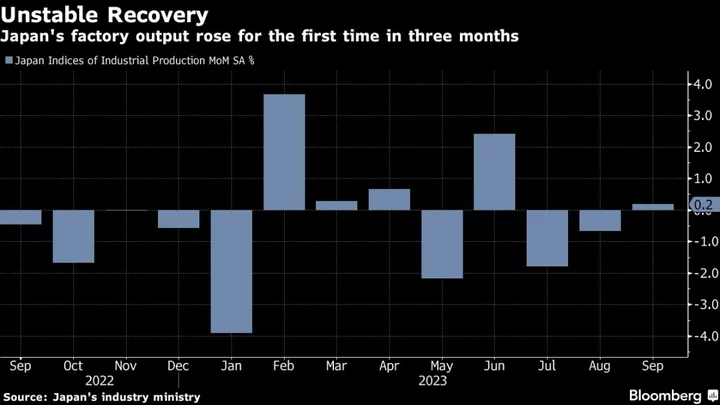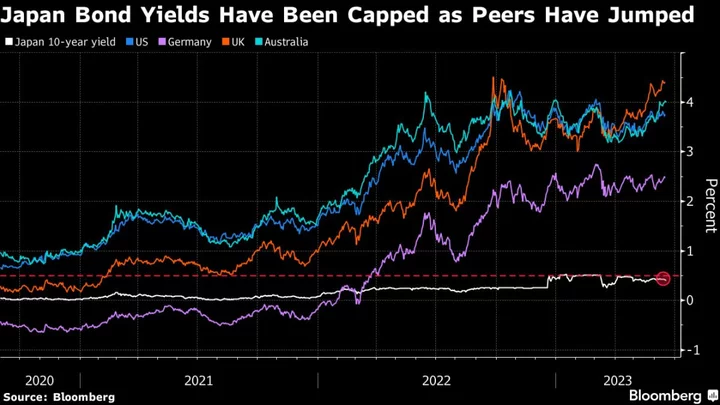A surprisingly strong US economy and mixed signals from the Federal Reserve have fueled some of the wildest swings in Treasuries in recent memory. Add geopolitical angst and a surge in debt supply and you have a recipe for sustained volatility for months to come, market watchers say.
Dubbed the “world’s safest asset,” Treasuries have proven anything but recently as dramatic moves in yields become an almost daily occurrence. Just this week, the rate on the 10-year swung in a range of almost 40 basis points, buffeted by crosscurrents including resilient retail sales and jobless figures, a bevy of comments from Fed officials and rising demand for haven assets amid concerns of an escalating conflict in the Middle East.
“It’s going to be a rough ride, so buckle up,” Mike Schumacher, head of macro strategy at Wells Fargo Securities, said this week on Bloomberg TV. Interest-rate volatility should “remain quite high, at least through the mid-point of next year, perhaps further as the Middle East sorts itself out” and until the market gets more clarity on the Fed.
The ICE BofA MOVE Index, which tracks anticipated swings in Treasury yields priced into one-month options, has risen for five-straight weeks. In fact, by one measure, swings in long-term rates are exceeding those for equities by the most in at least 18 years, according to data compiled by Bloomberg.
That’s partly because the Fed is struggling to signal a longer-term vision for where interest-rate policy is headed, according to Mohamed El-Erian, the chief economic adviser at Allianz SE and a Bloomberg Opinion columnist.
“We are going to remain in this situation of great uncertainty because there is no vision as to where this economy is going,” El-Erian said on Bloomberg TV Friday. “They need to pivot from excessive data dependence to data dependence that has a greater forward-looking component.”
Amid the past week’s ructions, nothing caused more chaos than Fed Chair Jerome Powell’s comments Thursday on the trajectory of monetary policy. He suggested at an event at the Economic Club of New York that the US central bank is inclined to hold interest rates steady at its next meeting, while leaving open the possibility of another hike later if policymakers see further signs of resilient economic growth.
The rates curve aggressively steepened in response, with short-dated yields sliding while longer-maturity ones climbed to fresh multiyear highs.
Geopolitics, Supply
Price swings last week were also fueled by mounting concerns that the war between Israel and Hamas could spread throughout the region, potentially even drawing in the US.
Reports of drone attacks in Iraq and Syria, cruise missiles fired toward Israel by Houthi rebels in Yemen and Israel’s strikes against Hamas and Hezbollah prompted a reactionary bid for safety among investors, causing 10-year yields to retrench from their highs just below 5% and end the week around 4.91%
Concerns about the US’s fiscal future are also increasingly affecting investor sentiment.
Growing US debt issuance has help lift the so-called term premium by more than a percentage point over the past three months, fueling a dramatic ascent in long-end rates. Traders are already bracing for the Treasury to announce further increases to auction sizes at its next quarterly refunding on Nov. 1.
“Volatility is begetting more volatility,” said William Marshall, head of US rates strategy at BNP Paribas SA. “There is just a general lack of strong conviction at this stage as to where things ought to be anchored.”
What Bloomberg Strategists Say...
“It’s hard to see what would drive a significant and sustained rally in bonds without a US recession. A downturn hinges on the services part of the economy, where the outlook is balanced..”
- Simon White, macro strategist
For the full note, click here
Looking ahead, a pause in Fed speak next week on account of the central bank’s customary blackout period ahead of the Nov. 1 policy meeting may be a welcome reprieve for traders.
Still, the coming days will provide some key readings on price pressures in the economy, including Friday’s personal-consumption expenditures data, the Fed’s preferred inflation measure. The University of Michigan inflation expectations survey will hit the same day.
What to Watch
- Economic data:
- Oct. 23: Chicago Fed national activity index
- Oct. 24: Philadelphia fed non-manufacturing activity; S&P Global US manufacturing, services; Richmond Fed manufacturing index/business conditions
- Oct. 25: MBA mortgage applications; New home sales
- Oct 26: Wholesale inventories; advance goods trade balance; GDP; Personal consumption; retail inventories; GDP price; durable goods; Core PCE price; initial jobless claims; pending home sales; Kansas city Fed manufacturing
- Oct 27: Personal income/spending; PCE deflator; U. of Michigan sentiment; Kansas City Fed services activity
- No Federal Reserve speakers slated during self-imposed quiet period ahead of Nov. 1 rate decision
- Auction calendar:
- Oct. 23: 13-, 26-week bills
- Oct. 24: 42-day cash management bills; 2-year notes
- Oct. 25: 17-week bills; 2-year floating rate notes; 5-year notes
- Oct. 26: 4-, 8-week bills; 7-year notes
--With assistance from Ye Xie and Elizabeth Stanton.









